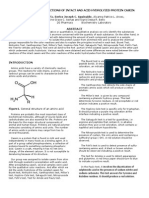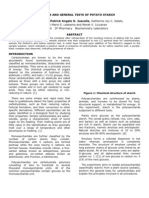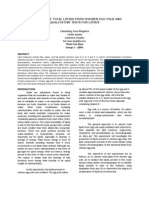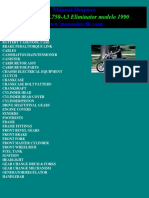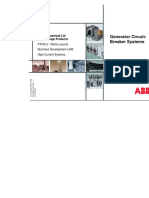Isolation and Characterization of Carbohydrates
Isolation and Characterization of Carbohydrates
Uploaded by
Nadz GonzalezCopyright:
Available Formats
Isolation and Characterization of Carbohydrates
Isolation and Characterization of Carbohydrates
Uploaded by
Nadz GonzalezOriginal Description:
Original Title
Copyright
Available Formats
Share this document
Read this document in other languages
Did you find this document useful?
Is this content inappropriate?
Copyright:
Available Formats
Isolation and Characterization of Carbohydrates
Isolation and Characterization of Carbohydrates
Uploaded by
Nadz GonzalezCopyright:
Available Formats
EXPERIMENT NO.
4: ISOLATION AND CHARACTERIZATION OF CARBOHYDRATES
Jill Cristine G. Genuino, Herald Jervy D. Go, Jianna Nadine B. Gonzalez, Luke Gian C. Guerrero, Paolo F. Gutierrez and Bienn Paulo Laforteza Group 4 2G Medical Technology Biochemistry Laboratory
ABSTRACT
Carbohydrates are the most abundant class of organic compounds found in living organisms. It is defined as any of a group of organic compounds that includes sugars, starches, celluloses, and gums and serves as a major energy source in the diet. The objective of this experiment is to isolate the polysaccharide glycogen from chicken liver and explain the principle involved in it and in the general tests done to determine the polysaccharide content of the sample. Some of the other goals of the experiment are to prepare a dialyzing bag, to perform TLC properly, to microscopically examine the different osazone and mucic acid crystals, and to classify unknown carbohydrates. Initially, the glycogen from chicken liver is isolated by heating and adding 0.1% acetic acid and then adding 5-10 drops of ethanol. It then undergoes the general tests for polysaccharides, including Molischs Test which uses 5% naphthol in 95% ethanol ( + : blue-violet colored ring) and I2 Reaction involving 0.01 M I2 ( + : bluish purple). The sample is also hydrolysed via acidic and enzymatic hydrolysis, after which it undergoes the qualitative tests for carbohydrates, namely Benedicts Test ( + : brick-red precipitate), Barfoeds Test ( + : brick-red precipitate), SeliwanoffS Test ( + : yellow to faint pink solution), Bials-Orcinol Test ( + : blue-green solution), Muric Acid Test, and Phenylhydrazone Test. TLC or thin layer chromatography is then performed, followed by a quantitative analysis of the samples using Nelsons method of measurement.
INTRODUCTION
Carbohydrates, also known as saccharides, are carbon compounds that contain large quantities of hydroxyl groups, and are also the most important sources of energy. They have the basic general formula Cn(H2O)n and they are the most commonly found organic compounds in living organisms. They are classified into several groups, namely monosaccharides, disaccharides, and polysaccharides, depending on the number of their monosaccharide units. Monosaccharides are further divided with regards to the number of carbons they have pentoses and hexoses. Pentoses contain five carbon atoms while hexoses contain six carbon atoms. They can also be classified as aldoses or ketoses. Aldoses contain one aldehyde group while ketoses contain one ketone group within the molecule. An oligosaccharides monosaccharide units, on the other hand, range from two to ten, all linked by glycosidic bonds (a covalent bond which binds between the hemiacetal group of a saccharide). It is different from polysaccharides because it contains multiple but few carbon atoms, whereas polysaccharides may contain up to hundreds of monosaccharide units. Oligosaccharides and polysaccharides are similar, however, in the fact that both of them can be hydrolysed by heating in a slightly acidic solution. Glycogen, the major glucose storage polymer in animals, has a highly branched structure which permits rapid release of glucose from glycogen stores, e.g., in muscle cells during exercise. The ability to rapidly mobilize glucose is more essential to animals than to plants. Glycogen is a very compact structure that results from the coiling of the polymer chains. This
compactness allows large amounts of carbon energy to be stored in a small volume, with little effect on cellular osmolarity. In this experiment, glycogen was isolated from the chicken liver via precipitation. Chicken liver is used in this experiment because it is a good source to isolate glycogen from. Since glycogen is used in movement of body structures, several other good sources from which it may be isolated are muscle tissues, beef or pork liver. The isolation of glycogen from the chicken liver is attained by using the mechanism of precipitation. By mincing, grinding, and boiling the liver, separation of the proteins from the glycogen found in the sample is elicited. The carbohydrate tests used in this experiment can be divided into two classifications based on the mechanism of action which takes place and on the reagents used in the tests. The first involves the use of dehydrating acids followed by condensation reagents. This is called the two-step analysis, which often than not yield highly coloured results. The second classification is that which makes use of copper (II) ion-containing reagents. The copper (II) ions are reduced to cuprous oxide copper (I) oxide by the carbohydrates present in the samples. The Molischs Test shows positive results (purple interface) for all carbohydrates, with monosaccharides reacting much faster than disaccharides and polysaccharides. The Iodine Test, on the other hand, is used to identify glycogen and starch. Polysaccharides combine with iodine to form a positive result (a blueblack colour). Acid hydrolysis is performed on the isolate using concentrated hydrochloric acid while enzymatic
hydrolysis is done using saliva and is to be stored in a dialyzing bag. The qualitative tests for carbohydrates which were performed for this experiment include Benedicts Test, Barfoeds Test, Seliwanoffs Test, Bials-Orcinol Test, most of which yield highly coloured and visible results, and Mucic Acid Test, and Phenylhydrazone Test, the products of which are to be microscopically examined and tested for solubility. The Benedict's test allows us to detect the presence of reducing sugars or sugars with a free aldehyde or ketone group. Barfoeds Test also detects the presence of reducing sugars. Seliwanoffs Test is used to detect ketoses sugars containing one ketone group per molecule while Bials-Orcinol Test is used to detect pentoses. Mucic Acid Test, named after the mucic acid, dicarboxylic, or galactaric acid it produces after the oxidation reaction takes place, is specifically useful in identifying galactose. Lastly, Phenylhydrazone Test differentiates reducing sugars via microscopic examination of the phenylhydrazones (osazones) formed from the reactions with phenylhydrazine and solubility in hot water.
0.1 M sucrose 1% starch
B. Procedure For Isolation of Glycogen
Weigh 3 g of chicken liver using an analytical balance and place on a Petri dish. Cut the sample with the use of scissors. Transfer sample to a beaker and pour 12 mL of distilled boiling water. Stir contents with a glass rod and boil for two minutes using a hot plate to precipitate the proteins in the sample. Pour the mixture into a mortar and use pestle to grind the sample thoroughly until no lumps are visible. Add 3 mL distilled water and transfer the mixture into a beaker. Heat the mixture in a boiling water bath for thirty minutes and, if necessary, add distilled water to the mixture to avoid evaporation since glycogen goes to the solution when heating. Filter solution using filter paper and separate glycogen samples into four portions and transfer to test tubes. *0.1% acetic acid may be added to improve precipitation of proteins during heating of sample in boiling water bath.
For Glycogen Precipitation by Ethanol EXPERIMENTAL A. Compounds Tested (or Samples Used) For Isolation of Glycogen
Chicken liver Boiling water 0.1% acetic acid Add five to ten drops of ethanol to 1 mL glycogen solution and observe precipitation.
For General Tests for Polysaccharides
MOLISCHS TEST Add a few drops of Molischs Reagent into 1 mL glycogen solution. Carefully pour 2 mL conc. H2SO4 down the side of a tube using a glass rod to form a purple interface. I2 REACTION Add a few drops of 0.01 M I2 into the sample solution measuring 1 mL. A red colour produced indicates the presence of glycogen. Warm the mixture in a water bath and observe if there is any change in colour. Cool and note the result.
For Glycogen Precipitation by Ethanol
Ethanol
For General Tests for Carbohydrates
5% naphthol in 95% ethanol Conc. H2SO4 0.01 M I2
For Hydrolysis of Polysaccharides
Conc. HCl Saliva
For Preparation of a Dialyzing Bag
Pour collodion solution into a clean and dry hard glass (ignition) tube. With the tube in a horizontal position, completely and carefully coat its inside by slowly rotating it while pouring off the excess collodion solution back into its container. Suspend the ignition tube so the inner coating of collodion solution will dry. When dried, loosen the coat from inside and slowly peel of the membrane.
For Qualitative Tests for Carbohydrates
Benedicts reagent Barfoeds reagent Seliwanoffs reagent Orcinol reagent Conc. HNO3 Phenylhydrazine HCl CH3COONa Distilled water 0.1 M glucose 0.1 M fructose 0.1 M xylose 0.1 M galactose 0.1 M lactose
For Hydrolysis of Polysaccharides
ACID HYDROLYSIS Add 5 drops conc. HCl into 5 mL of the isolate. Cover the test tube with a marble and boil it in water bath for thirty minutes. Keep the hydrolysate for Benedicts Test. *Store the hydrolysate in a refrigerator if the test cannot be performed on the same day.
ENZYMATIC HYDROLYSIS Place 10 mL isolated carbohydrate in a beaker. Add 2.3 mL saliva. Allow it to stand at room temperature for about thirty minutes and take note of any changes in the hydrolysates viscosity. Pour the solution into a dialyzing bag and suspend the bag overnight in a small flask or beaker with 50 mL distilled water. Remove and discard the dialyzing bag. Concentrate the solution inside the flask using an open flame to the volume of 10 mL. Test for the presence of reducing sugar in the hydrolysate by performing Benedicts Test.
The glycogen elicited a positive result upon the addition of Molischs Reagent and conc. sulfuric acid because the Molischs Test is a test for carbohydrates. It also produced a positive result for I2 Reaction because it will react with glycogen found in a polysaccharide or in a solution.
Table 2. Results for Qualitative Tests for Carbohydrates
Visible Results Carbohydrate Solution Seliwanoffs Benedicts Barfoeds
For Qualitative Tests for Carbohydrates
BENEDICTS, BERFOEDS, SELIWANOFFS, AND BIALS TESTS In separate test tubes, mix 5 drops of the 0.1 M carbohydrate solutions (glucose, fructose, xylose, lactose, sucrose, and starch) and 1 mL of the required reagent for each test. Perform one test on the different carbohydrate solutions at the same time. Place all the test tubes at the same time into a boiling water bath. Remove the tubes from the water bath when solutions for one test give visible colour results. Note the result and the time it took for the visible result to form for each test. MURIC ACID TEST Mix 3 drops of the carbohydrate solution (galactose, lactose) and 3 drops of HNO3 on a glass slide. Pass the mixture over a small flame from an alcohol lamp until it is almost dry. Cool at room temperature. Examine the crystals under the microscope and draw the mucic acid crystals. If no crystals appear, let the glass slide stand until the next period. PHENYLHYDRAZONE TEST Prepare the phenylhydrazine reagent by mixing 2 g phenylhydrazine hydrochloride, 3 g CH3COONa, and 10 mL distilled water. Place reagent in a warm water bath. Stir until solution clears. In different test tubes, mix 2 drops of carbohydrate solution (glucose, fructose, xylose, lactose, sucrose, and starch) with 4 drops of freshly prepared phenylhydrazine reagent. Mix well and cover the tubes with cotton. Heat in a boiling water bath for 30 minutes and record the time when yellow crystals first appear. Cool the tubes and observe the crystals under the microscope. Draw the different phenylhydrazones (osazones).
Glucose Fructose Xylose Lactose Sucrose Starch Glycogen Hydrolysate
(+) (+) (+) (+) () () ()
(+) (+) (+) () () () ()
() (+) (+) (+) (+) (+) ()
(+) () (+) () () () (+)
Benedicts Test is a test to detect the presence of reducing sugars. The reagent used contains copper (II) ions in alkaline solution with sodium citrate to keep the cupric ions in the solution. The alkalinity of the solution causes ketoses to form isomers and become aldoses, reducing the cupric ions to cuprous oxide. Barfoeds Test shows positive for reducing monosaccharides. Its mechanism of action relies on the mildness of the condition of the environment which elicits the oxidation of the sugars. Seliwanoffs Test is used to distinguish aldoses from ketoses. This is because ketoses undergo dehydration to form hydroxymethylfurfural which forms a cherry red, pale pink or yellow condensate when reacted with the resorcinol from the reagent. Lastly, Bials Test detects the presence of pentoses found within the sample. Pentoses dehydrate to form furfural which condenses with orcinol to form a blue-green solution.
RESULTS AND DISCUSSIONS Table 1. Results for General Tests for Polysaccharides
Test Molischs Test Results (+) Purple interface
Figure 1. Positive Result for Molischs Test and Iodide Test Respectively
I2 Reaction
(+) Deep red colour
Bials
The purple interface is shown as the product of the Molisch Test, a test for carbohydrates. A deep red colour, indicating a positive reaction, is meanwhile seen as the product of the Iodide test which detects the presence of glycogen.
References
http://www2.chemistry.msu.edu/faculty/reusch/VirtTxtJml/car bhyd.htm http://www.answers.com/topic/carbohydrate http://chemistry2.csudh.edu/rpendarvis/monosacch.html http://www.chacha.com/question/what-is-the-formula-forglycosidic-linkage-formation http://themedicalbiochemistrypage.org/carbohydrates.php http://answers.yahoo.com/question/index?qid=200809112133 02AACHBrn http://www.harpercollege.edu/tmps/chm/100/dgodambe/thedisk/carbo/molisch/molisch.htm http://www.biosci.ohiou.edu/introbioslab/Bios170/170_2/bene dict.htm http://www.harpercollege.edu/tmps/chm/100/dgodambe/thedisk/carbo/barf/barfoed.htm http://www.harpercollege.edu/tmps/chm/100/dgodambe/thedisk/carbo/seli/seli.htm
Figure 2. Positive Result for Benedicts, Barfoeds, Seliwanoffs, and Bials Tests Respectively
Figure 3. Microscopic Observations of the Osazones of Sucrose, Xylose, Fructose, Lactose, Starch, and Glucose Respectively
http://en.wikipedia.org/wiki/Ketose http://www.harpercollege.edu/tmps/chm/100/dgodambe/thedisk/carbo/bial/bials.htm http://www.slideshare.net/katealyssacaton/mucic-andbarfoeds-test http://autumnmarcita.wordpress.com/2010/10/11/carbohydra tes/ http://himedialabs.com/TD/HTBC002.pdf
You might also like
- Daman Standard Dental Pricelist (USCLS)Document28 pagesDaman Standard Dental Pricelist (USCLS)Asadulla Khan83% (6)
- Experiment 5 - GlycogenDocument5 pagesExperiment 5 - GlycogenGrace Aquino67% (6)
- Liber Loagaeth: Liber Mysteriorum, Sextus Et SanctusDocument13 pagesLiber Loagaeth: Liber Mysteriorum, Sextus Et Sanctusabirrado100% (1)
- Reaction of LipidsDocument5 pagesReaction of LipidsJason Raquin Roque89% (9)
- LipidsDocument25 pagesLipidsJeaniee Zosa Ebias50% (10)
- Laboratory Experiment 2 Colloids and Their PropertiesDocument5 pagesLaboratory Experiment 2 Colloids and Their PropertiesRenee Dwi Permata MessakaraengNo ratings yet
- Isolation and Characterization of CarbohydratesDocument7 pagesIsolation and Characterization of CarbohydratesKyle Dillan LansangNo ratings yet
- Biochemistry ExperimentDocument10 pagesBiochemistry ExperimentAlyssa Pelayo100% (4)
- Lipids in Egg Yok BiochemistryDocument8 pagesLipids in Egg Yok BiochemistryDayledaniel Sorveto33% (3)
- Rna IsolationDocument2 pagesRna IsolationL-yeah Traifalgar63% (8)
- Results and Discussion For CarbohydratesDocument4 pagesResults and Discussion For CarbohydratesDusky25% (4)
- Lab 11Document8 pagesLab 11Algenne Amiruddin100% (1)
- COLLOIDS Lab ReportDocument2 pagesCOLLOIDS Lab ReportVine Castro50% (2)
- Qualitative Color Reactions of Intact and Acid Hydrolyzed Protein CaseinDocument3 pagesQualitative Color Reactions of Intact and Acid Hydrolyzed Protein CaseinEric Aguinaldo67% (3)
- Experiment 1 - Chicken Liver: Molisch TestDocument5 pagesExperiment 1 - Chicken Liver: Molisch TestKeyna Dizon50% (2)
- Experiment 1 & 2 Habitan, Sheena Joy C. 2Bsph1 08/24/21Document4 pagesExperiment 1 & 2 Habitan, Sheena Joy C. 2Bsph1 08/24/21SHEENA JOY HABITANNo ratings yet
- Isolation and Characterization of Casein From Non-Fat Powdered MilkDocument5 pagesIsolation and Characterization of Casein From Non-Fat Powdered MilkGabriella JavierNo ratings yet
- Experiment 9 - The Chemistry of UrineDocument7 pagesExperiment 9 - The Chemistry of UrineMark Ryan TripoleNo ratings yet
- Plate Tectonics QuizDocument6 pagesPlate Tectonics QuizJordan Santos100% (1)
- Isolation and General Tests For CarbohydratesDocument3 pagesIsolation and General Tests For CarbohydratesPatrick Juacalla33% (3)
- Isolation From Chicken Liver and Enzymatic Hydrolysis of GlycogenDocument2 pagesIsolation From Chicken Liver and Enzymatic Hydrolysis of GlycogenAngela ResicoNo ratings yet
- Isolation, Hydrolysis, and Characterization of GlycogenDocument4 pagesIsolation, Hydrolysis, and Characterization of GlycogenRyan Enriquez100% (1)
- Isolation From Chicken Liver and Enzymatic Hydrolysis of GlycogenDocument2 pagesIsolation From Chicken Liver and Enzymatic Hydrolysis of GlycogenKevin Magadia78% (9)
- Analysis of Saliva SNDocument2 pagesAnalysis of Saliva SNMauralenAbadinesCabaguingNo ratings yet
- Isolation and Characterization of CarbohydratesDocument31 pagesIsolation and Characterization of CarbohydratesBenhur Leithold Lapitan50% (8)
- Exp. 3 Test For The Presence of Carbohydrates Molisch TestDocument4 pagesExp. 3 Test For The Presence of Carbohydrates Molisch TestEdchel0% (1)
- General and Specific Tests For CarbohydratesDocument13 pagesGeneral and Specific Tests For CarbohydratesKai Chen50% (2)
- Experiment 6 - CarbohydratesDocument4 pagesExperiment 6 - CarbohydratesShaira Dawn PlancoNo ratings yet
- Qualitative Tests For CarbohydratesDocument6 pagesQualitative Tests For CarbohydratesJennifer Heredia0% (1)
- Pre-Lab: Analysis of Lipids in Egg YolkDocument2 pagesPre-Lab: Analysis of Lipids in Egg YolkABIGAIL JUNEAU LEE100% (1)
- Extraction of Total Lipids From Chicken Egg Yolk and Qualitative Test For LipidsDocument4 pagesExtraction of Total Lipids From Chicken Egg Yolk and Qualitative Test For LipidsKizer Dela CruzNo ratings yet
- Exp. 4 LipidsDocument6 pagesExp. 4 LipidsAna LuisaNo ratings yet
- Biochem Lab ReportDocument4 pagesBiochem Lab ReportChryza Faith QuicoyNo ratings yet
- Experiment 4 LipidsDocument5 pagesExperiment 4 Lipidsjayco son100% (1)
- Picric Acid TestDocument2 pagesPicric Acid TestHOly makaroniNo ratings yet
- Mucic Acid TestDocument16 pagesMucic Acid TestTom Anthony Tonguia0% (3)
- Biochemistry (2 - Isolation & Characterization of Proteins)Document17 pagesBiochemistry (2 - Isolation & Characterization of Proteins)Daena Timtiman100% (1)
- Experiment 5Document9 pagesExperiment 5Ames Morales TorresNo ratings yet
- Protein Isolation and CharacterizationDocument5 pagesProtein Isolation and CharacterizationJoana Marie Rodriguez Ontog50% (2)
- Hydrolysis of Nucleic AcidsDocument7 pagesHydrolysis of Nucleic Acidskeepersake81% (16)
- Lipids Chemical TestDocument9 pagesLipids Chemical TestMiles Acosta100% (3)
- Analysis Exp 8Document4 pagesAnalysis Exp 8Chin T. OndongNo ratings yet
- Laboratory Experiment 1 Water and Its PropertiesDocument6 pagesLaboratory Experiment 1 Water and Its PropertiesRenee Dwi Permata Messakaraeng50% (2)
- Qualitative Test For LipidsDocument3 pagesQualitative Test For LipidsJeandra Villanueva100% (2)
- Nucleic AcidDocument34 pagesNucleic AcidEinah Einah100% (1)
- Isolation and Characterization of Gluten From Wheat FlourDocument3 pagesIsolation and Characterization of Gluten From Wheat FlourFrancesca PerezNo ratings yet
- Lab Report LipidsDocument5 pagesLab Report LipidsKhamis Tolentino100% (1)
- Lipids: Francisco, Ryan Joseph EDocument9 pagesLipids: Francisco, Ryan Joseph EAxl DilagNo ratings yet
- Experiment 5: Characteristic Reactions of HydrocarbonsDocument7 pagesExperiment 5: Characteristic Reactions of HydrocarbonsJorelle NogoyNo ratings yet
- Chem162L Lab Report - Salivary DigestionDocument6 pagesChem162L Lab Report - Salivary DigestionMay'n Dert93% (15)
- Color Test For Nucleic Acid ComponentsDocument2 pagesColor Test For Nucleic Acid ComponentsrJ100% (1)
- Experiment No. 4 GLYCOGENDocument2 pagesExperiment No. 4 GLYCOGENMissy Arabella PameNo ratings yet
- Test For PurinesDocument2 pagesTest For PurinesYholzManio100% (1)
- Experiment No. 3: CarbohydratesDocument6 pagesExperiment No. 3: CarbohydratesAna LuisaNo ratings yet
- LAb 6Document20 pagesLAb 63amabelle arevalo100% (2)
- Qualitative Analysis of Lipids Through The Extraction of Total Lipids From Chicken Egg YolkDocument5 pagesQualitative Analysis of Lipids Through The Extraction of Total Lipids From Chicken Egg YolkJessa Mateum VallangcaNo ratings yet
- Experiment 5 LipidsDocument13 pagesExperiment 5 LipidsClemence Marie FuentesNo ratings yet
- Elementary Composition of ProteinsDocument2 pagesElementary Composition of ProteinsJoyan ChiongNo ratings yet
- Formal Report-Proteins and Amino AcidsDocument10 pagesFormal Report-Proteins and Amino AcidsQuenieMarielIlar100% (1)
- Acrolein TestDocument6 pagesAcrolein TestJesserene Ramos80% (5)
- Formal Report FamsDocument4 pagesFormal Report FamsAlexander David FamadulanNo ratings yet
- Isolation and Characterization of CarbohydratesDocument4 pagesIsolation and Characterization of CarbohydratesEvans DionNo ratings yet
- Isolation, General Tests, and Hydrolysis of Polysaccharides Formal ReportDocument4 pagesIsolation, General Tests, and Hydrolysis of Polysaccharides Formal ReportJuliefer May Fanilag Pleños100% (1)
- ZAFER, Bulk Carrier - Details and Current Position - IMO 9579315 - VesselFinder 2Document1 pageZAFER, Bulk Carrier - Details and Current Position - IMO 9579315 - VesselFinder 2zgspxrzky6No ratings yet
- Lecture 1 ProsthodonticDocument62 pagesLecture 1 ProsthodonticaudreyNo ratings yet
- Phonetics and Phonology L&LDocument21 pagesPhonetics and Phonology L&LRupam ChandelNo ratings yet
- KATALOG VIII Niczuk FINAL ENG Jan 2019 WebDocument269 pagesKATALOG VIII Niczuk FINAL ENG Jan 2019 WebBartos MiklosNo ratings yet
- Pahang GPS Levelling Base Report2Document25 pagesPahang GPS Levelling Base Report2AimanNo ratings yet
- PassiveVoiceExercises - AnswerDocument2 pagesPassiveVoiceExercises - AnswerAkmal ThariqNo ratings yet
- 596054-2023-specimen-paper-4-mark-schemeDocument8 pages596054-2023-specimen-paper-4-mark-schemeAdil Yaqub - 74665/TCHR/CNTBNo ratings yet
- Soal PTS 1 Bhs Inggris Peminatan Kelas XIIDocument15 pagesSoal PTS 1 Bhs Inggris Peminatan Kelas XIIrayhanckpoyNo ratings yet
- Gyne Past Papers Update 5Document139 pagesGyne Past Papers Update 5Misbah KaleemNo ratings yet
- 2N06CL Intersil 986T04 Harris 1617 0283Document19 pages2N06CL Intersil 986T04 Harris 1617 0283Danny Everson100% (1)
- Panchayat RajDocument254 pagesPanchayat RajramkumarlsNo ratings yet
- Bab 1Document5 pagesBab 1emeldagraceNo ratings yet
- IMO Maths Sample Paper 1 For Class 3Document16 pagesIMO Maths Sample Paper 1 For Class 3anuNo ratings yet
- Despiece ZL 750 PDFDocument120 pagesDespiece ZL 750 PDFAriel MuñozNo ratings yet
- A Generalized Approach For The Study of The Non Linear Behaviour PDFDocument5 pagesA Generalized Approach For The Study of The Non Linear Behaviour PDFrenzomcuevaNo ratings yet
- 44NETF Module 16 Network Security Fundamentals v2022Document37 pages44NETF Module 16 Network Security Fundamentals v2022khant59037No ratings yet
- British Airways EmiratesDocument5 pagesBritish Airways Emiratesmubeen yaminNo ratings yet
- Mining Crushing and ScreeningDocument16 pagesMining Crushing and Screeningqlan VsNo ratings yet
- The Implementation of An Efficient FPGA-based Digital Controller For Solar PanelsDocument12 pagesThe Implementation of An Efficient FPGA-based Digital Controller For Solar Panelsسعيد ابوسريعNo ratings yet
- WarrickDocument1 pageWarrickChristian DanyNo ratings yet
- Spatial Location-Allocation Modeling of Bike Sharing Systems: A Literature SearchDocument15 pagesSpatial Location-Allocation Modeling of Bike Sharing Systems: A Literature SearchjansenNo ratings yet
- 8th Computer Sat - ADocument3 pages8th Computer Sat - Aanuj32No ratings yet
- Articulation IndexDocument5 pagesArticulation IndexaniketkoliNo ratings yet
- FAEN 101: Algebra: Dr. Joseph K. AnsongDocument32 pagesFAEN 101: Algebra: Dr. Joseph K. Ansongnimdie jacksonNo ratings yet
- Graphic Design Essentials With Adobe Software 2nd Joyce Walsh Download PDFDocument24 pagesGraphic Design Essentials With Adobe Software 2nd Joyce Walsh Download PDFtanyueuilian100% (1)
- (Generator Circuit - Breaker Systems - ABB - ) Marta+lacorte - PDF Version 1 PDFDocument38 pages(Generator Circuit - Breaker Systems - ABB - ) Marta+lacorte - PDF Version 1 PDFFarris Elektrik IpohNo ratings yet
- Ground Improvement TechniquesDocument5 pagesGround Improvement TechniquesebinVettuchirayil100% (1)













